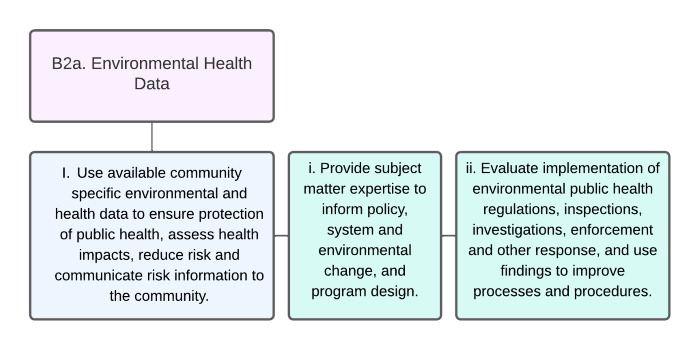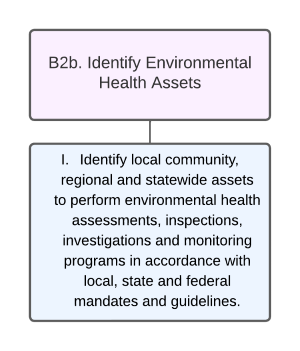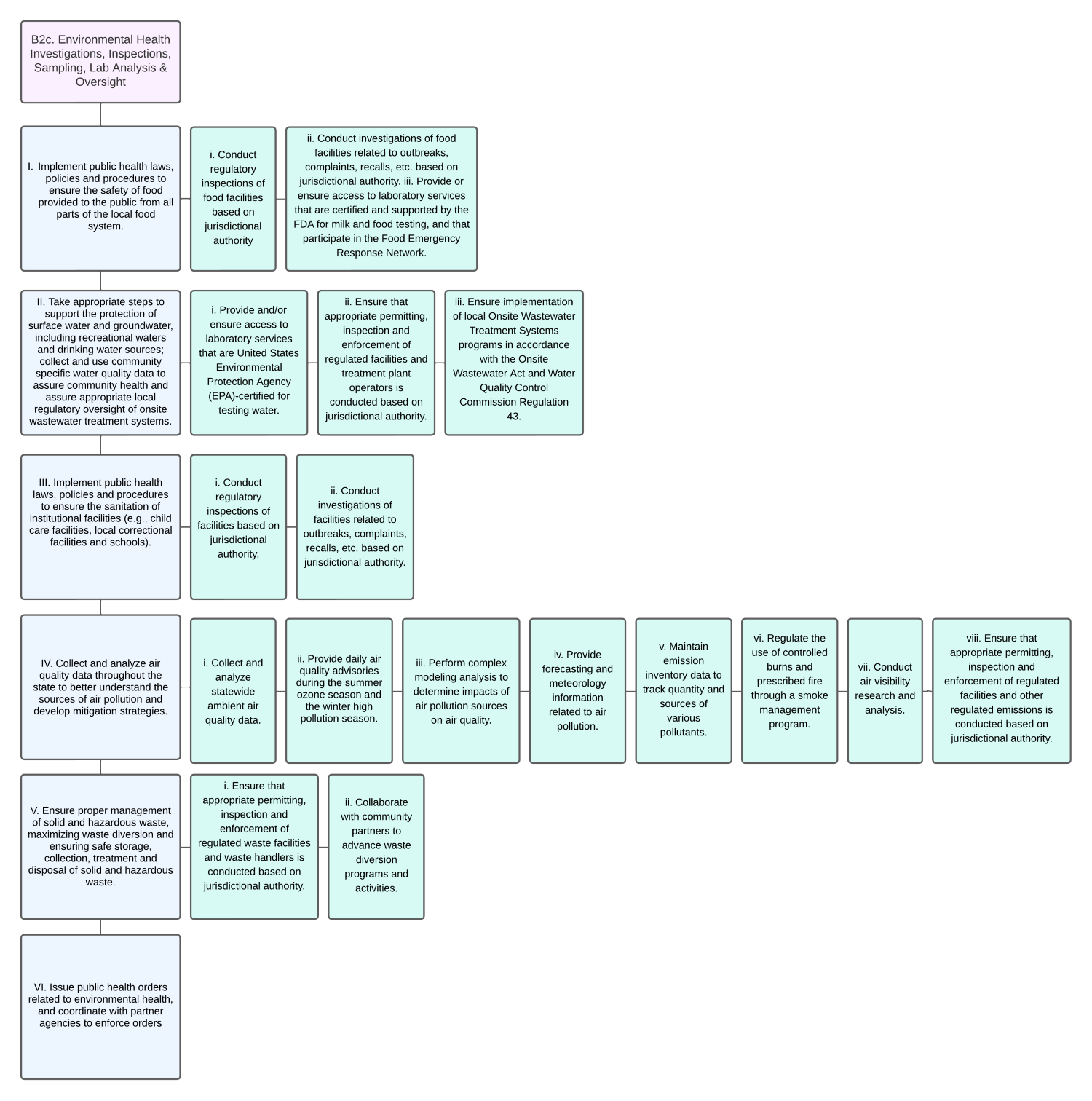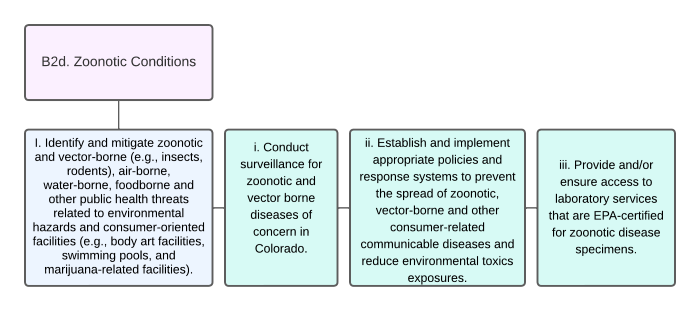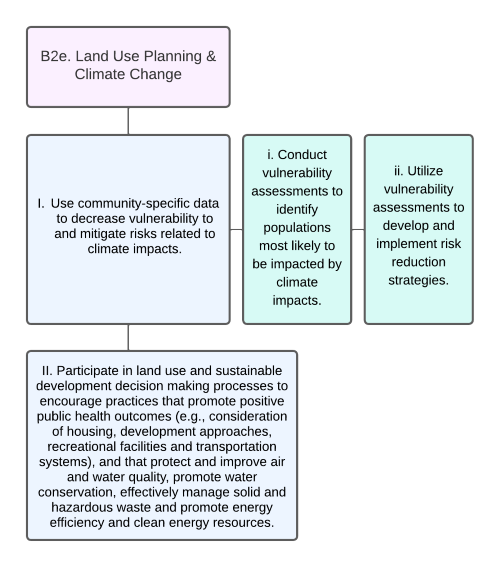B2. Environmental Public Health

Environmental Public Health: Colorado’s governmental public health system will use evidence-informed practices to understand the cause and effect relationships between environmental changes and ecological and human health impacts, to protect, promote, and enhance the health of the community and environment.
Agencies will participate in the protection and improvement of air quality, water, land, and food safety by identifying, investigating, and responding to community environmental health concerns, reducing current and emerging environmental health risks, preventing communicable diseases, and sustaining the environment in a coordinated manner with agencies at the federal, state, and local levels as well as industry stakeholders and the public.
Links:
- CDPHE Air Pollution Control Division (APCD)
- CDPHE Division of Environmental Health and Sustainability (DEHS)
- CDPHE Hazardous Materials and Waste Management Division (HMWMD)
- CDPHE Water Quality Control Division (WQCD)
- PDF of B2 Flow Chart
The source Core Public Health Services Operational Definitions Manual 2019 is organized as follows:
|
Functions of Environmental Health
B2a. Environmental Health Data
I. Use available community specific environmental and health data to ensure protection of public health, assess health impacts, reduce risk and communicate risk information to the community.
i. Provide subject matter expertise to inform policy, system and environmental change, and program design.
ii. Evaluate implementation of environmental public health regulations, inspections, investigations, enforcement and other response, and use findings to improve processes and procedures.
B2b. Identify Environmental Health Assets
I. Identify local community, regional and statewide assets to perform environmental health assessments, inspections, investigations and monitoring programs in accordance with local, state and federal mandates and guidelines.
B2c. Environmental Health Investigations, Inspections, Sampling, Lab Analysis and Oversight
I. Implement public health laws, policies and procedures to ensure the safety of food provided to the public from all parts of the local food system.
i. Conduct regulatory inspections of food facilities based on jurisdictional authority
ii. Conduct investigations of food facilities related to outbreaks, complaints, recalls, etc. based on jurisdictional authority. iii. Provide or ensure access to laboratory services that are certified and supported by the FDA for milk and food testing, and that participate in the Food Emergency Response Network.
II. Take appropriate steps to support the protection of surface water and groundwater, including recreational waters and drinking water sources; collect and use community specific water quality data to assure community health and assure appropriate local regulatory oversight of onsite wastewater treatment systems.
i. Provide and/or ensure access to laboratory services that are United States Environmental Protection Agency (EPA)-certified for testing water.
ii. Ensure that appropriate permitting, inspection and enforcement of regulated facilities and treatment plant operators is conducted based on jurisdictional authority.
iii. Ensure implementation of local Onsite Wastewater Treatment Systems programs in accordance with the Onsite Wastewater Act and Water Quality Control Commission Regulation 43.
III. Implement public health laws, policies and procedures to ensure the sanitation of institutional facilities (e.g., child care facilities, local correctional facilities and schools).
i. Conduct regulatory inspections of facilities based on jurisdictional authority.
ii. Conduct investigations of facilities related to outbreaks, complaints, recalls, etc. based on jurisdictional authority.
IV. Collect and analyze air quality data throughout the state to better understand the sources of air pollution and develop mitigation strategies.
i. Collect and analyze statewide ambient air quality data.
ii. Provide daily air quality advisories during the summer ozone season and the winter high pollution season.
iii. Perform complex modeling analysis to determine impacts of air pollution sources on air quality.
iv. Provide forecasting and meteorology information related to air pollution.
v. Maintain emission inventory data to track quantity and sources of various pollutants. vi. Regulate the use of controlled burns and prescribed fire through a smoke management program.
vii. Conduct air visibility research and analysis.
viii. Ensure that appropriate permitting, inspection and enforcement of regulated facilities and other regulated emissions is conducted based on jurisdictional authority.
V. Ensure proper management of solid and hazardous waste, maximizing waste diversion and ensuring safe storage, collection, treatment and disposal of solid and hazardous waste.
i. Ensure that appropriate permitting, inspection and enforcement of regulated waste facilities and waste handlers is conducted based on jurisdictional authority.
ii. Collaborate with community partners to advance waste diversion programs and activities.
VI. Issue public health orders related to environmental health, and coordinate with partner agencies to enforce orders.
B2d. Zoonotic Conditions
I. Identify and mitigate zoonotic and vector-borne (e.g., insects, rodents), air-borne, water-borne, foodborne and other public health threats related to environmental hazards and consumer-oriented facilities (e.g., body art facilities, swimming pools, and marijuana-related facilities).
i. Conduct surveillance for zoonotic and vector borne diseases of concern in Colorado.
ii. Establish and implement appropriate policies and response systems to prevent the spread of zoonotic, vector-borne and other consumer-related communicable diseases and reduce environmental toxics exposures.
iii. Provide and/or ensure access to laboratory services that are EPA-certified for zoonotic disease specimens.
B2e. Land Use Planning and Climate Change
I. Use community-specific data to decrease vulnerability to and mitigate risks related to climate impacts.
i. Conduct vulnerability assessments to identify populations most likely to be impacted by climate impacts.
ii. Utilize vulnerability assessments to develop and implement risk reduction strategies.
II. Participate in land use and sustainable development decision making processes to encourage practices that promote positive public health outcomes (e.g., consideration of housing, development approaches, recreational facilities and transportation systems), and that protect and improve air and water quality, promote water conservation, effectively manage solid and hazardous waste and promote energy efficiency and clean energy resources.
B2f. Coordination of Other Environmental Health Services with Foundational Capabilities and Services
I. When public health services are delivered regarding environmental health, ensure they are coordinated with foundational capabilities and services.
